Redis为何如此之快
- Redis基本是内存操作,所以速度很快
内存:
1. 寻址时间:纳秒级别ns
2. 带宽:很大
磁盘:
1. 寻址时间:毫秒级别ms
2. 带宽:G/M
磁盘比内存寻址慢了10W倍以上,所以单机Redis能支持每秒10W以上的请求- Redis通信采用非阻塞IO, 内部实现采用epolll+自己实现的简单的事件框架。epoll中的读、写、关闭、连接都转化成了事件,然后利用epoll的多路复用特性,绝不在io上浪费一点时
- 单机Redis采用单进程、单线程、单实例,避免了不必要的上下文切换和竞争条件
可能很多人认为要想系统处理速度快不是应该使用多线程技术。但其实Redis的数据都是放在内存中,查询存储都延时都非常小,是纳秒级别的,所以如果使用多线程,就需要加锁,系统资源还需要耗费在线程之间上下文切换上面,反而会影响性能。单进程、单线程天生就保证了请求的顺序执行,不需要加锁,也没有了不必要的上下文切换,因此可以将硬件的性能发挥到极致
总结:这3个条件不是相互独立的,特别是第一条,如果请求都是耗时的,采用单线程吞吐量及性能可想而知了。应该说Redis为特殊的场景选择了合适的技术方案。
Epoll的高性能如何成就Redis
I/O模型 BIO、NIO、多路复用I/O、AIO
1. 阻塞I/O(Blocking I/O BIO)
应用程序进程/线程如果发起1K个请求,则开启1K个socket文件描述符,socket在等待内核返回数据时是阻塞式的,数据未准备好就一直阻塞等待,一次只会返回一个socket结果,直到返回数据后才等待下一个socket的返回
BIO Server端代码
public class Server {
public static void main(String[] args) throws IOException {
ServerSocket ss = new ServerSocket();
ss.bind(new InetSocketAddress("127.0.0.1", 8888));
while(true) {
Socket s = ss.accept(); //阻塞方法
//新起线程来处理client端请求,让主线程可以接受下一个client的accept
new Thread(() -> {
handle(s);
}).start();
}
}
static void handle(Socket s) {
try {
byte[] bytes = new byte[1024];
int len = s.getInputStream().read(bytes); //阻塞方法
System.out.println(new String(bytes, 0, len));
s.getOutputStream().write(bytes, 0, len); //阻塞方法
s.getOutputStream().flush();
} catch (IOException e) {
e.printStackTrace();
}
}
}BIO Client端代码
public class Client {
public static void main(String[] args) throws IOException {
Socket s = new Socket("127.0.0.1", 8888);
s.getOutputStream().write("HelloServer".getBytes());
s.getOutputStream().flush();
//s.getOutputStream().close();
System.out.println("write over, waiting for msg back...");
byte[] bytes = new byte[1024];
int len = s.getInputStream().read(bytes);
System.out.println(new String(bytes, 0, len));
s.close();
}
}2. 轮询非阻塞I/O(Non-Blocking I/O NIO)
应用进程如果发起1K个请求,则在用户空间不停轮询这1K个socket文件描述符,查看是否有结果返回。这种方法虽然不阻塞,但是效率太低,有大量无效的循环
单线程NIO Server代码:
一个selector做所有的事,既有accept、又有read
public class Server {
public static void main(String[] args) throws IOException {
ServerSocketChannel ssc = ServerSocketChannel.open();
ssc.socket().bind(new InetSocketAddress("127.0.0.1", 8888));
ssc.configureBlocking(false);
System.out.println("server started, listening on :" + ssc.getLocalAddress());
Selector selector = Selector.open();
ssc.register(selector, SelectionKey.OP_ACCEPT);
while(true) {
selector.select(); //阻塞方法
Set<SelectionKey> keys = selector.selectedKeys();
Iterator<SelectionKey> it = keys.iterator();
while(it.hasNext()) {
SelectionKey key = it.next();
it.remove();
handle(key);
}
}
}
private static void handle(SelectionKey key) {
if(key.isAcceptable()) { //判断为连接请求
try {
ServerSocketChannel ssc = (ServerSocketChannel) key.channel();
SocketChannel sc = ssc.accept();
sc.configureBlocking(false);
//new Client
//
//String hostIP = ((InetSocketAddress)sc.getRemoteAddress()).getHostString();
/*
log.info("client " + hostIP + " trying to connect");
for(int i=0; i<clients.size(); i++) {
String clientHostIP = clients.get(i).clientAddress.getHostString();
if(hostIP.equals(clientHostIP)) {
log.info("this client has already connected! is he alvie " + clients.get(i).live);
sc.close();
return;
}
}*/
sc.register(key.selector(), SelectionKey.OP_READ );
} catch (IOException e) {
e.printStackTrace();
} finally {
}
} else if (key.isReadable()) { //判断为读请求
SocketChannel sc = null;
try {
sc = (SocketChannel)key.channel();
//需要flip复位操作,写的时候很难用
ByteBuffer buffer = ByteBuffer.allocate(512);
buffer.clear();
int len = sc.read(buffer);
if(len != -1) {
System.out.println(new String(buffer.array(), 0, len));
}
ByteBuffer bufferToWrite = ByteBuffer.wrap("HelloClient".getBytes());
sc.write(bufferToWrite);
} catch (IOException e) {
e.printStackTrace();
} finally {
if(sc != null) {
try {
sc.close();
} catch (IOException e) {
e.printStackTrace();
}
}
}
}
}
}NIO-reactor Server代码:
一个selector只负责accept(Boss),对每个client的handler由一个线程池处理(Workers)
public class PoolServer {
ExecutorService pool = Executors.newFixedThreadPool(50);
private Selector selector;
//中文测试
/**
*
* @throws IOException
*/
public static void main(String[] args) throws IOException {
PoolServer server = new PoolServer();
server.initServer(8000);
server.listen();
}
/**
*
* @param port
* @throws IOException
*/
public void initServer(int port) throws IOException {
//
ServerSocketChannel serverChannel = ServerSocketChannel.open();
//
serverChannel.configureBlocking(false);
//
serverChannel.socket().bind(new InetSocketAddress(port));
//
this.selector = Selector.open();
serverChannel.register(selector, SelectionKey.OP_ACCEPT);
System.out.println("服务端启动成功!");
}
/**
*
* @throws IOException
*/
@SuppressWarnings("unchecked")
public void listen() throws IOException {
// 轮询访问selector
while (true) {
//
selector.select();
//
Iterator ite = this.selector.selectedKeys().iterator();
while (ite.hasNext()) {
SelectionKey key = (SelectionKey) ite.next();
//
ite.remove();
//
if (key.isAcceptable()) {
ServerSocketChannel server = (ServerSocketChannel) key.channel();
//
SocketChannel channel = server.accept();
//
channel.configureBlocking(false);
//
channel.register(this.selector, SelectionKey.OP_READ);
//
} else if (key.isReadable()) {
//
key.interestOps(key.interestOps()&(~SelectionKey.OP_READ));
//
pool.execute(new ThreadHandlerChannel(key));
}
}
}
}
}
/**
*
* @param
* @throws IOException
*/
class ThreadHandlerChannel extends Thread{
private SelectionKey key;
ThreadHandlerChannel(SelectionKey key){
this.key=key;
}
@Override
public void run() {
//
SocketChannel channel = (SocketChannel) key.channel();
//
ByteBuffer buffer = ByteBuffer.allocate(1024);
//
ByteArrayOutputStream baos = new ByteArrayOutputStream();
try {
int size = 0;
while ((size = channel.read(buffer)) > 0) {
buffer.flip();
baos.write(buffer.array(),0,size);
buffer.clear();
}
baos.close();
//
byte[] content=baos.toByteArray();
ByteBuffer writeBuf = ByteBuffer.allocate(content.length);
writeBuf.put(content);
writeBuf.flip();
channel.write(writeBuf);//
if(size==-1){
channel.close();
}else{
//
key.interestOps(key.interestOps()|SelectionKey.OP_READ);
key.selector().wakeup();
}
}catch (Exception e) {
System.out.println(e.getMessage());
}
}
}画外音:为什么NIO只有server代码,没有client代码?------因为Client可以用BIO的代替啊
3. 多路复用I/O(Multiplexing I/O)
select:能打开的文件描述符个数有限(最多1024个),如果有1K个请求,用户进程每次都要把1K个文件描述符发送给内核,内核在内部轮询后将可读描述符返回,用户进程再依次读取。因为文件描述符(fd)相关数据需要在用户态和内核态之间拷来拷去,所以性能还是比较低
poll:可打开的文件描述符数量提高,因为用链表存储,但性能仍然不够,和selector一样数据需要在用户态和内核态之间拷来拷去
epoll(Linux下多为该技术):用户态和内核态之间不用文件描述符(fd)的拷贝,而是通过mmap技术开辟共享空间,所有fd用红黑树存储,有返回结果的fd放在链表中,用户进程通过链表读取返回结果,伪异步I/O,性能较高。epoll分为水平触发和边缘出发两种模式,ET是边缘触发,LT是水平触发,一个表示只有在变化的边际触发,一个表示在某个阶段都会触发
用Netty的示例代码来展现一下epoll的应用层用法
Server代码:
public class HelloNetty {
public static void main(String[] args) {
new NettyServer(8888).serverStart();
}
}
class NettyServer {
int port = 8888;
public NettyServer(int port) {
this.port = port;
}
public void serverStart() {
EventLoopGroup bossGroup = new NioEventLoopGroup();
EventLoopGroup workerGroup = new NioEventLoopGroup();
ServerBootstrap b = new ServerBootstrap();
b.group(bossGroup, workerGroup)
.channel(NioServerSocketChannel.class)
.childHandler(new ChannelInitializer<SocketChannel>() {
@Override
protected void initChannel(SocketChannel ch) throws Exception {
ch.pipeline().addLast(new Handler());
}
});
try {
ChannelFuture f = b.bind(port).sync();
f.channel().closeFuture().sync();
} catch (InterruptedException e) {
e.printStackTrace();
} finally {
workerGroup.shutdownGracefully();
bossGroup.shutdownGracefully();
}
}
}
class Handler extends ChannelInboundHandlerAdapter {
@Override
public void channelRead(ChannelHandlerContext ctx, Object msg) throws Exception {
//super.channelRead(ctx, msg);
System.out.println("server: channel read");
ByteBuf buf = (ByteBuf)msg;
System.out.println(buf.toString(CharsetUtil.UTF_8));
ctx.writeAndFlush(msg);
ctx.close();
//buf.release();
}
@Override
public void exceptionCaught(ChannelHandlerContext ctx, Throwable cause) throws Exception {
//super.exceptionCaught(ctx, cause);
cause.printStackTrace();
ctx.close();
}
}
Client代码:
public class Client {
public static void main(String[] args) {
new Client().clientStart();
}
private void clientStart() {
EventLoopGroup workers = new NioEventLoopGroup();
Bootstrap b = new Bootstrap();
b.group(workers)
.channel(NioSocketChannel.class)
.handler(new ChannelInitializer<SocketChannel>() {
@Override
protected void initChannel(SocketChannel ch) throws Exception {
System.out.println("channel initialized!");
ch.pipeline().addLast(new ClientHandler());
}
});
try {
System.out.println("start to connect...");
ChannelFuture f = b.connect("127.0.0.1", 8888).sync();
f.channel().closeFuture().sync();
} catch (InterruptedException e) {
e.printStackTrace();
} finally {
workers.shutdownGracefully();
}
}
}
class ClientHandler extends ChannelInboundHandlerAdapter {
@Override
public void channelActive(ChannelHandlerContext ctx) throws Exception {
System.out.println("channel is activated.");
final ChannelFuture f = ctx.writeAndFlush(Unpooled.copiedBuffer("HelloNetty".getBytes()));
f.addListener(new ChannelFutureListener() {
@Override
public void operationComplete(ChannelFuture future) throws Exception {
System.out.println("msg send!");
//ctx.close();
}
});
}
@Override
public void channelRead(ChannelHandlerContext ctx, Object msg) throws Exception {
try {
ByteBuf buf = (ByteBuf)msg;
System.out.println(buf.toString());
} finally {
ReferenceCountUtil.release(msg);
}
}
}
4. 异步I/O AIO
AIO:异步I/O,性能最高,但是使用非常复杂,不是很常用(windows系统中多见,Java中有AIO,API在Linux上还是用epoll实现)
Redis的I/O总结
多路复用技术的发展代表目前I/O发展的方向。
select --- 只支持1024个句柄,轮询导致性能下降
poll --- 支持句柄数增多,性能仍然不高
epoll --- 支持句柄数增多,事件性驱动,性能高
Redis的I/O采用Linux下最先进的epoll,包括Netty也是使用的epoll(后续会有文章专门研究Netty)
AIO虽然更加先进,但是写起来更加复杂,而且在Linux内核下还没有真正支持AIO,但是Windows支持AIO
正是Redis作者对性能极致的追求,才成就了今天Redis在缓存界的霸主地位,选择Redis就是选择了高性能!!!
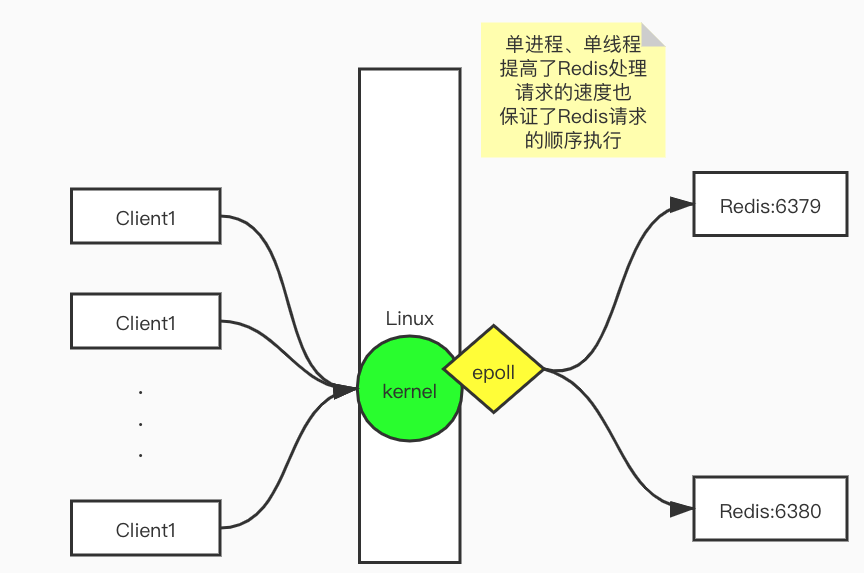
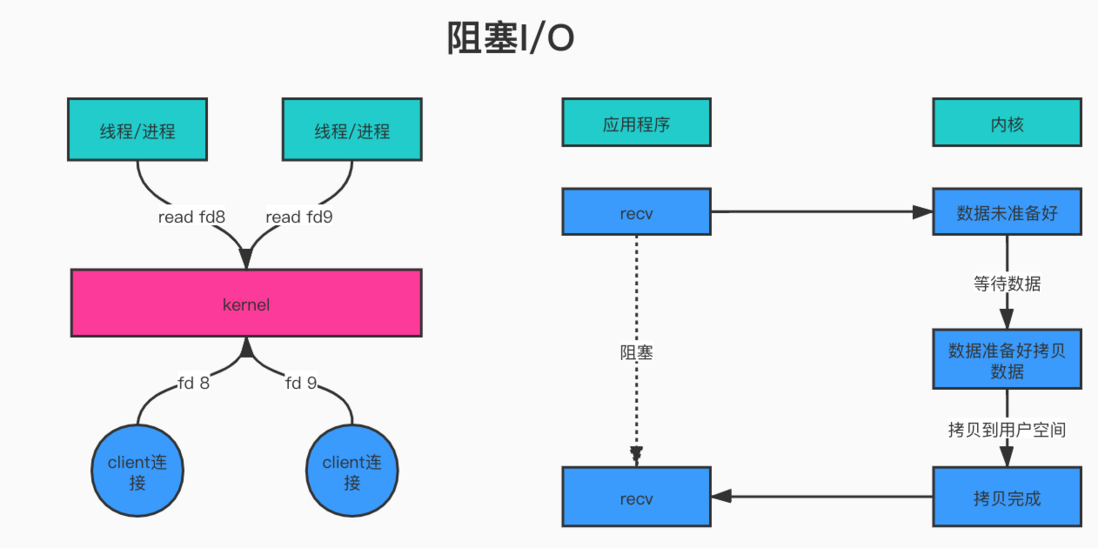

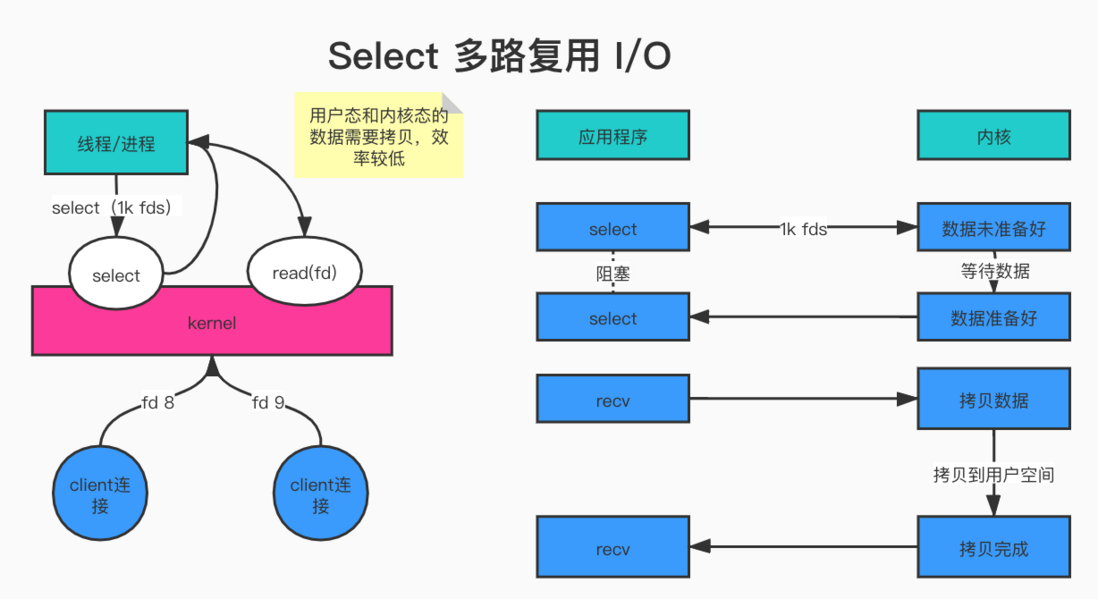
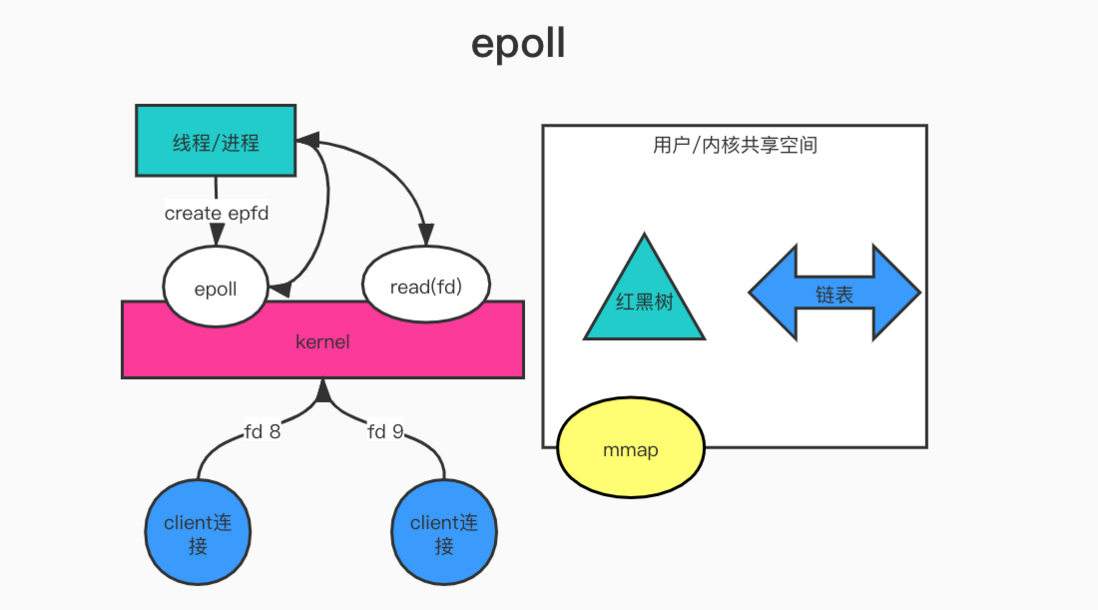
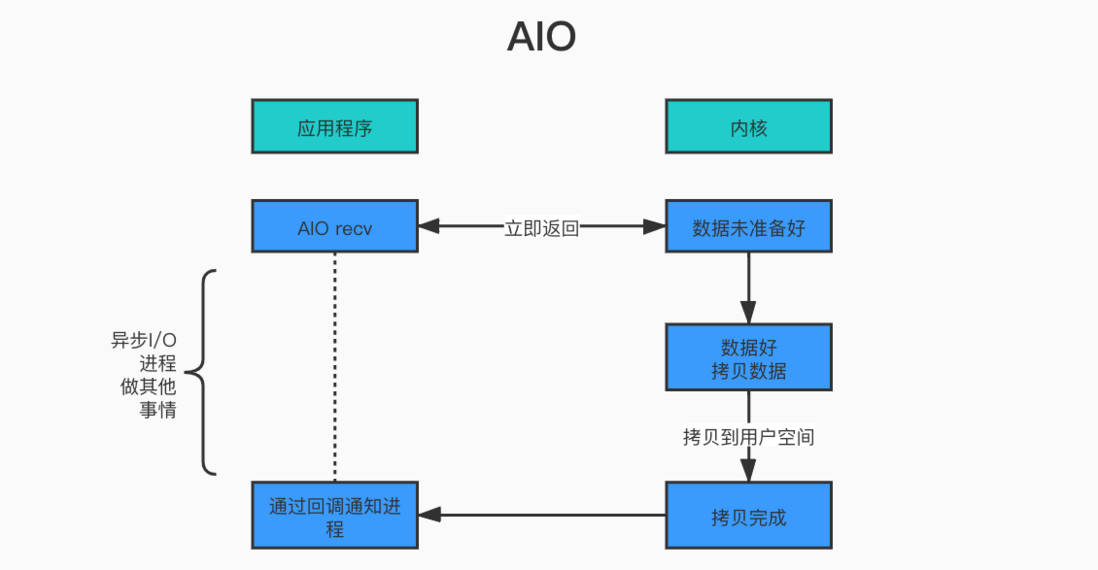
**粗体** _斜体_ [链接](http://example.com) `代码` - 列表 > 引用。你还可以使用@来通知其他用户。